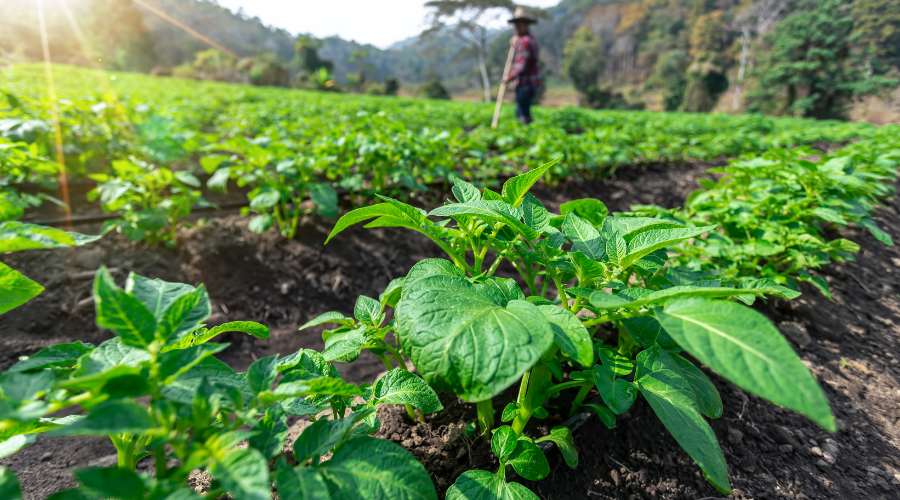Potatoes are a staple food in many countries, playing a crucial role in the global food market.
As one of the most versatile and widely-consumed crops, potatoes offer a wealth of opportunities for entrepreneurs looking to enter the agricultural sector.
This blog post will provide you with a step-by-step guide on starting your own potato farming business, covering everything from understanding the basics of potato farming to scaling your operations.
Understanding the basics of potato farming
Types of potatoes and their market demand
There are over 4,000 varieties of potatoes worldwide, but they can be broadly categorized into three types: russet, red, and white.
Each type has its own market demand, with russet potatoes being popular for baking and frying, red potatoes for boiling and roasting, and white potatoes for mashing and use in salads.
Research the preferences of your target market to determine which type(s) of potatoes will yield the best returns for your business.
Ideal climate and soil conditions for potato farming
Potatoes thrive in cool, temperate climates with consistent temperatures between 45-80°F.
The ideal soil for potato farming is well-draining, slightly acidic (pH 5.0-6.0), and rich in organic matter.
Sandy loam soils are often preferred, as they allow for easy tuber development and harvesting.
Basic requirements for starting a potato farm
To begin a potato farming business, you will need access to suitable land, high-quality seed potatoes, farming equipment, irrigation systems, and skilled labor.
You will also need to develop a strong understanding of potato farming best practices, including crop rotation, pest and disease management, and post-harvest handling.
Creating a business plan
Setting clear goals and objectives
Your business plan should outline your goals and objectives, such as the size of your operation, the variety of potatoes you intend to grow, and your target market.
Be specific and realistic in setting these goals, as they will serve as the foundation for your entire operation.
Estimating startup costs and ongoing expenses
Estimate the costs associated with starting your potato farming business, including land acquisition or leasing, equipment purchases, seed potatoes, labor, and other expenses.
Additionally, estimate your ongoing operational costs, such as irrigation, pest and disease management, and labor.
Having a clear understanding of your financial requirements will be crucial for securing funding and ensuring your business’s long-term success.
Analyzing market opportunities and competition
Research the current market for potatoes in your region, including potential buyers, competitors, and pricing trends.
This information will help you identify market gaps and opportunities, allowing you to differentiate your product and carve out a niche for your business.
Developing a marketing and sales strategy
Outline your approach to marketing your potatoes, including your target audience, promotional tactics, and sales channels.
Your strategy should focus on building relationships with buyers, distributors, and retailers, as well as creating a strong brand identity that differentiates your product from competitors.
Planning for potential risks and contingencies
Every business faces risks, and potato farming is no exception. Plan for potential challenges, such as weather events, pest and disease outbreaks, and market fluctuations, by developing contingency plans and allocating resources to address these issues if they arise.
Securing funding and resources
Exploring funding options (loans, grants, investors)
There are several ways to secure funding for your potato farming business, including loans, grants, and investments from private investors or venture capitalists.
Research the various funding options available to you, and choose the one that best aligns with your business goals and objectives.
Acquiring land and necessary equipment
Once you have secured funding, you will need to acquire or lease suitable land for your potato farming operation.
Look for land with the ideal soil and climatic conditions discussed earlier, and ensure that it has access to a reliable water source for irrigation.
Additionally, purchase or lease the necessary farming equipment, such as tractors, plows, planters, and harvesters, based on your operation’s size and requirements.
Sourcing high-quality seed potatoes
The success of your potato farm depends largely on the quality of your seed potatoes.
Source certified, disease-free seed potatoes from reputable suppliers to ensure healthy, high-yielding crops. Consider the market demand for specific potato varieties when making your selection.
Hiring skilled labor and staff
Hire skilled laborers and staff with experience in potato farming to assist with tasks such as land preparation, planting, irrigation, and harvesting.
Providing training and resources for your employees can help improve their skills and contribute to your farm’s overall success.
Preparing the land and planting potatoes
Soil preparation and nutrient management
Proper soil preparation is essential for potato farming success.
Begin by conducting soil tests to determine nutrient levels and pH.
Based on the results, amend the soil with organic matter, such as compost, and any necessary fertilizers to create the optimal growing conditions for potatoes.
Planting techniques and best practices
Plant your seed potatoes in rows, spaced 12-18 inches apart with 30-36 inches between rows, depending on the variety.
Place the seed potatoes 3-4 inches deep in the soil, with the eyes facing upward.
Ensure proper crop rotation to minimize the risk of soil-borne diseases and pests, and promote healthy soil fertility.
Pest and disease control strategies
Implement integrated pest management (IPM) strategies to minimize the impact of pests and diseases on your potato crop.
Monitor your fields regularly for early signs of infestations, and use a combination of biological, cultural, and chemical control methods as needed.
Consult with local agricultural extension services for guidance on the most effective pest and disease management practices for your region.
Irrigation and water management
Potatoes require consistent moisture throughout the growing season.
Develop an efficient irrigation system that provides uniform water distribution, and schedule irrigation based on soil moisture levels and local climatic conditions.
Avoid over-watering, as this can lead to tuber rot and other diseases.
Harvesting and post-harvest management
Determining the right time to harvest
The appropriate time to harvest potatoes depends on the variety and intended use.
Generally, potatoes are ready for harvest when the foliage begins to die back and the tubers’ skins have set.
Conduct periodic test digs to determine the maturity and quality of your crop.
Harvesting techniques and equipment
Use specialized potato harvesters or manual labor to dig up the potatoes, taking care not to damage the tubers during the process.
Ensure that your harvesting equipment is well-maintained and operated by skilled laborers.
Proper storage and handling practices
After harvesting, potatoes should be cured in a well-ventilated area with temperatures of 50-60°F for 10-14 days.
Once cured, store potatoes in a cool, dark, and well-ventilated space with a temperature of 40-45°F and relative humidity of 90-95%.
Proper storage and handling practices will help maintain the quality and shelf life of your potatoes.
Grading and packaging for market
Sort and grade your potatoes based on size, shape, and quality.
Package your potatoes in clean, well-ventilated containers that meet industry standards and buyer preferences.
Proper grading and packaging can help improve the marketability of your product and fetch higher prices.
Marketing and Selling your Potato Crop
Identifying target markets (wholesale, retail, export)
Determine your target market by considering the size of your operation, the potato varieties you are growing, and the preferences of potential buyers.
Options may include selling to wholesalers, retailers, or exporting your potatoes to other countries.
Each market has its own requirements and expectations, so it’s essential to tailor your approach accordingly.
Building relationships with buyers and distributors
Establish strong relationships with buyers and distributors by providing high-quality products and excellent customer service.
Attend industry events, join local trade organizations, and engage with potential buyers through social media and other marketing channels to build and maintain connections.
Promoting your potato farming business through branding and advertising
Develop a strong brand identity for your potato farming business by creating a unique logo, designing eye-catching packaging, and crafting a compelling brand story.
Use advertising, public relations, and social media to promote your business and reach your target audience.
Consistent branding and effective marketing can help differentiate your potatoes from competitors and attract loyal customers.
Participating in industry events and networking opportunities
Participate in industry events, such as trade shows, conferences, and seminars, to stay informed about the latest trends, technologies, and best practices in potato farming.
Networking with other farmers, buyers, and industry professionals can provide valuable insights and help you identify new opportunities for growth.
Scaling your potato farming business
Evaluating the success of your initial operations
After your first season of potato farming, evaluate the success of your operation by analyzing factors such as crop yield, profitability, and customer satisfaction.
Identify areas of improvement and implement changes as needed to optimize your farming practices and business strategies.
Identifying areas for improvement and expansion
As your potato farming business grows, look for opportunities to expand your operation, such as increasing acreage, adopting new technologies, or diversifying your product offerings.
Expanding your business can help increase your market share, spread risk, and improve overall profitability.
Adopting new technologies and farming practices
Stay informed about new technologies and farming practices that can improve your potato farming operation’s efficiency and productivity.
Examples include precision agriculture tools, new irrigation systems, and sustainable farming practices.
Incorporating these innovations into your business can help you stay competitive and increase profits.
Diversifying your product offerings (organic, specialty potatoes)
Consider diversifying your product offerings to meet evolving consumer demands and preferences.
For example, you could grow organic potatoes, which often fetch higher prices, or experiment with specialty potato varieties that cater to niche markets.
Diversification can help reduce risk and increase your business’s resilience in the face of market fluctuations.
Conclusion
Starting a potato farming business requires careful planning, hard work, and a commitment to continuous improvement.








